Some daily sky sights among the ever-changing Moon, planets, and stars.
Six weeks after it erupted, the nova in the Sagittarius Teapot continues to vary between about magnitude 4.5 and 6; it has dipped and re-risen four times. As of May 7th it was about 5.4. If it's a "slow nova," it may yet reach a new, highest peak in coming months. It's well up in the south before the beginning of dawn. See article with charts and a link to an up-to-date light curve.
Friday, May 1
For May Day, Venus in the west shines directly between the horn-tips of Taurus: Zeta and Beta Tauri. It's closest to the brighter one, Beta (Elnath).
The nearly-full Moon shines a few degrees above Spica this evening. Far off to their left or upper left is brighter Arcturus.
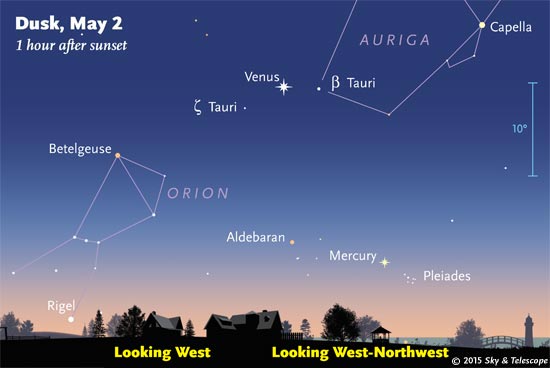
Saturday, May 2
May has come, but wintry Sirius still twinkles low in the southwest as twilight fades — off the left edge of the scene above. How much later into the spring can you keep Sirius in view?
Sunday, May 3
Full Moon (exact at 11:42 p.m. Eastern Daylight Time). The full Moon of May shines in Libra.
Monday, May 4
The bright Moon rises in twilight. As evening grows late, look below the Moon for Saturn, and then below Saturn for Antares.
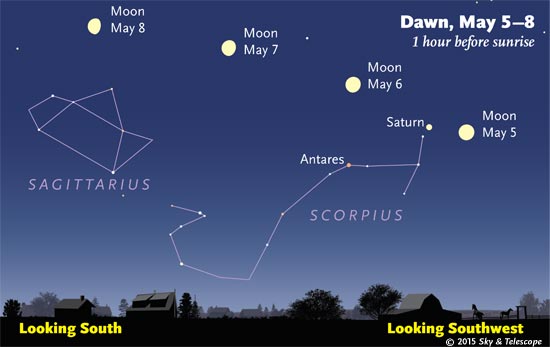
Tuesday, May 5
Look low in the northeast in twilight for the rising of Vega, the "Summer Star." By nightfall Vega shines higher in better view. As it gains altitude it grows to be the equal of Arcturus, the "Spring Star" very high in the east (far to the upper right). They're both magnitude zero.
Late this evening, the waning gibbous Moon forms a triangle with Saturn to its upper right and Antares to its lower right.
Wednesday, May 6
Summer is more than six weeks away, but the Summer Triangle is beginning to make its appearance in the east, one star after another. The first in view is Vega. It's already visible low in the northeast as twilight fades.
Next up is Deneb, lower left of Vega by two or three fists at arm's length. Deneb takes about an hour to appear after Vega does, depending on your latitude.
The third is Altair, which shows up far to their lower right around midnight.
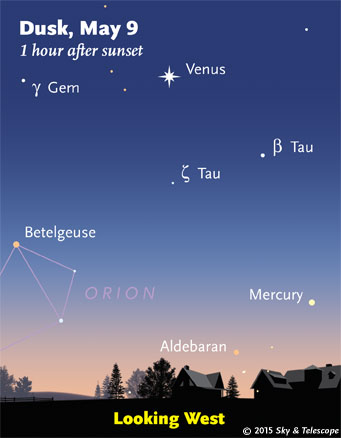
Thursday, May 7
Canes Venatici, the Hunting Dogs, floats near the zenith these evenings, inside the curl of the Big Dipper's handle. Now that the waning Moon doesn't rise until two hours after dark, go galaxy hunting here with Sue French's Deep-Sky Wonders article and chart in the May Sky & Telescope, page 56.
Friday, May 8
The two brightest points in sky are Venus and Jupiter. At dusk they're in the west and high in the southwest, respectively. Find the halfway point between them. A little upper right of there is Pollux, with Castor to its right.
Saturday, May 9
Three zero-magnitude stars shine after dark in May: Arcturus very high in the southeast, Vega much lower in the northeast, and Capella in the northwest. They appear so bright because each is at least 60 times as luminous as the Sun, and because they're all relatively nearby: 37, 25, and 42 light-years from us, respectively.
__________________________
Want to become a better astronomer? Learn your way around the constellations. They're the key to locating everything fainter and deeper to hunt with binoculars or a telescope.

Once you get a telescope, to put it to good use you'll need a detailed, large-scale sky atlas (set of charts). The standards are the little Pocket Sky Atlas, which shows stars to magnitude 7.6; the larger and deeper Sky Atlas 2000.0 (stars to magnitude 8.5); and once you know your way around, the even larger Uranometria 2000.0 (stars to magnitude 9.75). And read how to use sky charts with a telescope.
You'll also want a good deep-sky guidebook, such as Sue French's Deep-Sky Wonders collection (which includes its own charts), Sky Atlas 2000.0 Companion by Strong and Sinnott, the bigger Night Sky Observer's Guide by Kepple and Sanner, or the beloved if dated Burnham's Celestial Handbook.
Can a computerized telescope replace charts? Not for beginners, I don't think, and not on mounts and tripods that are less than top-quality mechanically (able to point with better than 0.2° repeatability, which means fairly heavy and expensive). As Terence Dickinson and Alan Dyer say in their Backyard Astronomer's Guide, "A full appreciation of the universe cannot come without developing the skills to find things in the sky and understanding how the sky works. This knowledge comes only by spending time under the stars with star maps in hand."
This Week's Planet Roundup
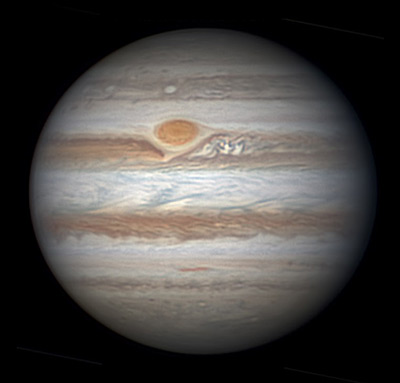
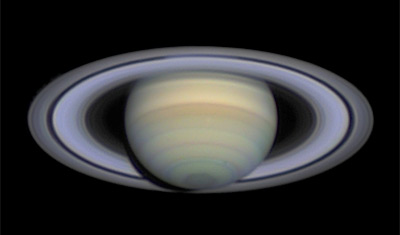
Mercury remains up in good view in evening twilight all week, but it's fading: from magnitude –0.3 on May 1st to +0.5 on the 8th. That's a loss of about half its brightness. Look for it far to the lower right of bright Venus.
Venus (magnitude –4.2, crossing from Taurus into Gemini) glares strikingly bright in the west during and after twilight — the "Evening Star." It doesn't set in the west-northwest until two hours after dark. In a telescope Venus is still gibbous, but it's thinning each week.
Mars is lost in the sunset.
Jupiter (magnitude –2.1, in Cancer) shines high in the south as the stars come out, and less high in the southwest later. It's the second-brightest point of light in the sky after Venus. In a telescope, Jupiter has shrunk to 38 or 37 arcseconds wide.
Saturn (magnitude +0.1, just above the head of Scorpius) rises around nightfall and reaches its highest point in the south around 2 a.m. daylight-saving time. Below Saturn by 9° or 10° is orange Antares, less bright. The next brightest star in the area is Delta Scorpii a little to their right (and about half as far from Saturn). Delta Sco is now in its 15th year of outburst!
If you observe Saturn with a telescope, also check out the fine double stars Beta Scorpii just 1.2° below Saturn, and Nu Scorpii 1.8° to Saturn's lower left.
Uranus is deep in the glow of dawn.
Neptune (magnitude +7.9, in Aquarius) is low in the east-southeast just before the beginning of dawn.
__________________________
All descriptions that relate to your horizon — including the words up, down, right, and left — are written for the world's mid-northern latitudes. Descriptions that also depend on longitude (mainly Moon positions) are for North America.
Eastern Daylight Time (EDT) is Universal Time (UT, UTC, or GMT) minus 4 hours.
__________________________
“This adventure is made possible by generations of searchers strictly adhering to a simple set of rules. Test ideas by experiments and observations. Build on those ideas that pass the test. Reject the ones that fail. Follow the evidence wherever it leads, and question everything. Accept these terms, and the cosmos is yours.”
— Neil deGrasse Tyson, 2014.
 0
0
Comments
You must be logged in to post a comment.